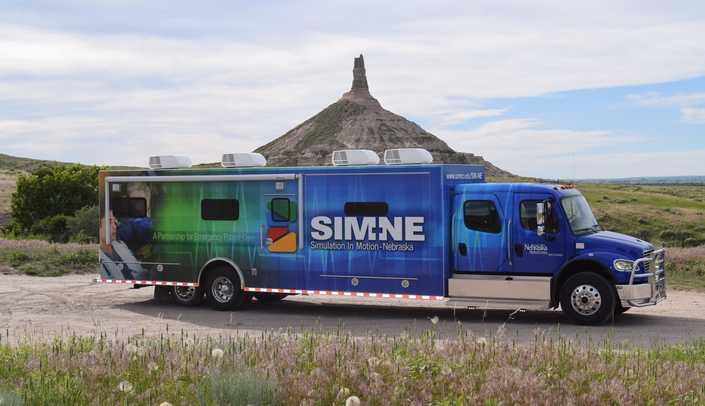In a holiday movie-miracle coincidence, Hildreth Fire and Rescue delivered a baby in an ambulance – less than 48 hours after specialized, high-tech training on emergency obstetrics from the University of Nebraska Medical Center’s Simulation-in-Motion Nebraska (SIM-NE).
A baby boy came into the world Nov. 15 not in a hospital bed, but on a country road, “Monday, 8:51 a.m., mile marker 32,” said proud father Kevin Gregory, of Franklin, Neb.
“My jaw is still on the floor when I think about it,” said Hildreth Fire and Rescue EMT Elizabeth Burki, who helped deliver the baby. “It makes me teary-eyed.”
It’s not a scenario rural EMTs, often volunteers, see every day. Or for decades.
But SIM-NE, a statewide mobile education system, provides state-of-the-art, hands-on training to emergency medical service providers in rural areas across the state, including health professionals in hospitals. SIM-NE provides free or low-cost training using four, 44-foot-long, customized trucks that supply mobile, real-life experiences designed to enhance lifesaving skills for those in rural areas.
“Thank God for the training,” Burki said, “I’m not even going to kid you.”
Ryan Knaus, who “caught” baby boy Raiden as he was being born, called SIM-NE simulation “spot on.”
“Everything I did (while training), I did in the back of that ambulance,” he said.
Gregory and mom Jasmine Gutschow were headed from Franklin, Nebraska, to her doctor in Kearney with two (small) soon-to-be big siblings in the car, when the vehicle broke down. They were almost a month before her due date. But, while the car refused to move, the contractions accelerated.
“I said, ‘You’ve just got to call 911,’” Gutschow said. “We’re not making it.”
With contractions piling on top of one another, Gregory, the dad, could hear the 911 dispatcher make the decision to call in the Hildreth squad. They were closest.
An emergency labor on the road? Right after they’d just trained for that specific scenario? Was it really happening?
“I got in the back of the ambulance,” Burki said. “I said ‘I can’t feel my fingertips and I think I’m going to throw up.’”
Knaus got there “30 seconds ahead of the ambulance.” Everyone pulled up, excited, but ready.
Did the squad mention to the family they’d just trained for this very scenario?
“We may have mentioned it a couple times,” Knaus said.
“They were fantastic,” Gutschow, the mom, said.
In another coincidence, the father of her pediatrician was on the squad, and he got his son, the doctor, on the phone.
“Having that connection there really helped,” Knaus said.
The decision was made: they were going to Minden, and Kearney County Health Services, which doesn’t normally deliver babies.
But then: “I said, ‘That’s a head,’” Burki said, “‘get down there, we’re catching this baby. We’re doing this.’ It was fast and awesome and amazing.”
SIM-NE's four trucks were launched in June 2017 and stationed in Scottsbluff, Norfolk, Kearney and Omaha. Rather than having learners travel to larger cities, the training is at the request of rural emergency medical service agencies and critical access hospital staff and is done in their communities. This also allows training to be team-based as learners train side-by-side with the people they normally work with during a response.
Burki and Knaus had practiced together, “And that’s exactly how it played out,” she said. “He caught that baby, and his attention went to the cord and my attention went to Raiden.”
She administered suction and oxygen – just as they’d practiced during their SIM-NE training.
“I am incredibly grateful for it.”
We are Nebraska Medicine and UNMC. Our mission is to lead the world in transforming lives to create a healthy future for all individuals and communities through premier educational programs, innovative research and extraordinary patient care.
Twitter | Facebook | Instagram | YouTube | Flickr
